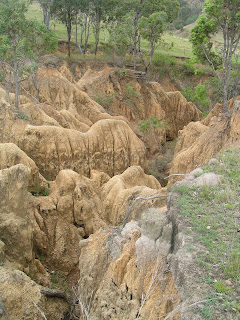Abstract
Increased
erosion associated with land use change often alters the flux of sediments and nutrients
but few studies have looked at the interaction between these disrupted
cycles. We studied the effects of gully
erosion on carbon (C) and nitrogen (N) storage in surface soil/sediment and herbaceous
vegetation, and on C and N mineralization in a headwater catchment used for cattle
grazing. We found significantly lower C and N stored in an incising gully
compared with an intact valley. This storage was significantly higher in an
adjacent stabilizing gully though not to the levels found in the intact valley. The intact valley had 2-4 times higher
soil/sediment concentrations of TOC, TN and Colwell-P than the incising gully. Lower storage was not explained by differences
in vegetation biomass density or silt and clay content. Vegetation accounted for only 8% of C and 2% of
N storage, respectively. While not a significant store in itself vegetation has
an important indirect role in restoring and maintaining soil/sediment C and N
stocks in eroding areas. We found
significant linear relationships between C and N mineralization rates and
soil/sediment C and N content, with lower rates occurring in the eroded sediment. These findings support our initial hypothesis
that gully erosion reduces C and N storage and mineralization rates in eroding
catchments. The implications of this
study include a change to the quality of eroded sediments in headwater
catchments, causing C- and N-poorer sediments to be exported but overall loads
to increase.Stream and River Restoration
The state of the worlds streams and rivers is of concern as stated in a recent Nature publication (Vorosmarty et al. 2010). The need to breach the gap between restoration science and applied restoration has been recognized as a condition for achieving success in this highly regarded goal. As a restoration scientist I hope this blog helps to gather related interesting information I come across with and also generates scientific discussions over issues I am dealing with during my PhD research.
Wednesday, 4 December 2013
Gully erosion reduces carbon and nitrogen storage and mineralization fluxes in catchments
This is my first PhD published paper:
Wednesday, 25 May 2011
Tuesday, 3 May 2011
Climate change ebook
This free ebook provides later scientific knowledge on climate change issues http://www.csiro.au/resources/Climate-Change-Book.html
Friday, 15 April 2011
Monday, 11 April 2011
Gully erosion
Gully erosion is the formation of channels on valleys that previously didn't have distinct concentrated water flows by the action of erosion. Gully erosion is a severe environmental problem in certain areas of Australia including South East Queensland. It contributes massive amounts of sediment to stream ecosystems in the region being one the major causes of their degradation.
These are some pictures of gullies in South East Queensland.

Gully restoration is of major importance to achieve river restoration in an affected catchment. It takes place naturally as the gully evolves towards stabilization but can be accelerated by human intervention. A stabilized gully achieves a new equilibrium between the settling and transport of sediments as rivers do and also becomes habitat for several species of plants and animals. Gullies in the dry upper catchments of Australia tend to behave as intermittent streams having flows only associated with rain events and drying out soon after.
These are some pictures of gullies in South East Queensland.

Gully restoration is of major importance to achieve river restoration in an affected catchment. It takes place naturally as the gully evolves towards stabilization but can be accelerated by human intervention. A stabilized gully achieves a new equilibrium between the settling and transport of sediments as rivers do and also becomes habitat for several species of plants and animals. Gullies in the dry upper catchments of Australia tend to behave as intermittent streams having flows only associated with rain events and drying out soon after.
Subscribe to:
Comments (Atom)





